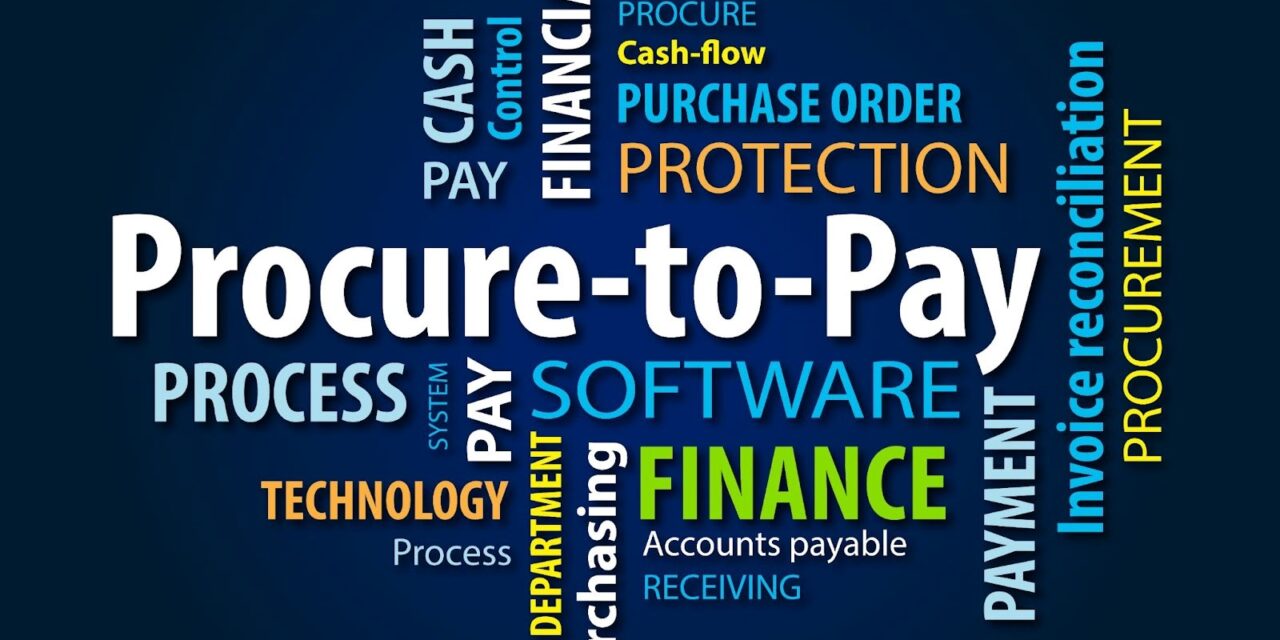In the dynamic landscape of modern business operations, the Procure-to-Pay (P2P) process stands as a linchpin, connecting the various facets of supply chain management into a seamless and efficient workflow.
P2P encapsulates a series of meticulously orchestrated steps that begin with the identification of a need for goods or services and culminate in the completion of the payment cycle. This method is important for organizations that want to improve how they use resources and strengthen relationships with suppliers. It helps in buying and managing money, making operations more effective.
The Essence of P2P
The essence of the Procure-to-Pay process lies in its ability to weave together disparate elements of an organization’s functioning into a cohesive and strategic framework. It transcends mere transactional activities and instead represents a strategic alignment of procurement goals with broader organizational objectives. By integrating requisitioning, sourcing, purchase order processing, goods receipt, invoice processing, payment processing, and reconciliation, P2P transforms the traditional procurement journey into a streamlined and value-driven continuum.
Navigating Key Components
- Requisitioning:
- Identification of Needs: The journey begins with the identification of organizational needs, whether they be tangible goods or intangible services. This crucial step involves collaboration between departments to accurately gauge requirements.
- Creation and Approval: Following the identification phase, the creation of purchase requisitions takes center stage. These requisitions, serving as the formal request for procurement, undergo a structured approval process to ensure alignment with budgetary constraints and organizational priorities.
- Sourcing:
- Supplier Identification and Evaluation: The sourcing phase is marked by the meticulous selection and evaluation of potential suppliers. Organizations leverage this stage to establish partnerships with entities that align not only with cost considerations but also with quality standards and ethical practices.
- Negotiation and Finalization: Negotiation, a delicate art within the procurement spectrum, takes place to finalize terms with chosen suppliers. This may involve price negotiations, contract terms, and other critical elements that contribute to the overall value proposition.
- Purchase Order (PO) Processing:
- Generation of POs: With agreements solidified, the procurement team generates purchase orders that formalize the commitment to suppliers. These documents serve as a binding contract, outlining the agreed-upon terms and conditions.
- Real-Time Tracking: The integration of technological solutions facilitates real-time tracking of POs, offering stakeholders visibility into the procurement pipeline and enabling proactive management of potential bottlenecks.
- Goods Receipt:
- Verification and Receipt: Upon the physical receipt of goods or completion of services, organizations initiate the goods receipt process. This phase involves meticulous verification, including inspection and quality checks, to ensure that the delivered items align with the agreed-upon specifications.
- Quality Checks: Quality assurance measures are paramount during the goods receipt phase, emphasizing the need for adherence to pre-established quality standards. Any deviations trigger corrective actions to maintain the integrity of the procurement process.
- Invoice Processing:
- Receipt and Validation: Supplier invoices, representing the financial aspect of the transaction, are received and subjected to validation. Automated solutions, such as optical character recognition (OCR), enhance accuracy and efficiency in data extraction, reducing the likelihood of errors.
- Three-Way Matching: The three-way matching process, involving the reconciliation of purchase orders, goods receipts, and supplier invoices, ensures a harmonized alignment of financial records. Discrepancies are identified and addressed to maintain accuracy.
- Payment Processing:
- Approval and Processing: The payment processing phase involves the approval and subsequent processing of payments to suppliers. Adherence to predetermined payment schedules and terms is crucial to maintain positive supplier relationships.
- Disbursement of Funds: Once approved, funds are disbursed to suppliers, marking the culmination of the financial transaction. Timeliness and accuracy in payment processing contribute significantly to supplier satisfaction and organizational credibility.
- Reconciliation:
- Matching Financial Records: The reconciliation phase involves a meticulous matching of financial records with procurement and receiving documentation. Any disparities are diligently investigated and resolved to ensure the accuracy and integrity of financial data.
The Seamless Integration of P2P
What makes the Procure-to-Pay process truly formidable is its ability to seamlessly integrate each of these components into a cohesive workflow. It transforms what could be a fragmented series of transactions into a strategic journey that optimizes resources, mitigates risks, and fosters robust supplier relationships. As we delve deeper into the intricacies of P2P, we will explore not only the best practices but also the technological innovations that are reshaping the landscape of procurement and financial processes.
Importance of a Robust P2P Process
The Procure-to-Pay (P2P) process serves as the backbone of an organization’s operations, offering far-reaching benefits that extend beyond the realm of procurement. As businesses navigate the intricacies of today’s competitive landscape, a well-optimized P2P process emerges as a strategic imperative. Let’s delve into the multifaceted significance of a robust P2P framework.
Cost Savings and Efficiency
At the core of P2P’s importance lies its profound impact on cost savings and operational efficiency. An effectively streamlined P2P process allows organizations to negotiate favorable terms with suppliers, optimize inventory levels, and eliminate unnecessary expenditures. By minimizing manual intervention and embracing automation, companies can significantly reduce the risk of errors and enhance the speed at which transactions are executed.
Negotiating Better Terms
A well-established P2P process provides organizations with the necessary insights and leverage to negotiate favorable terms with suppliers. By aggregating procurement data and analyzing historical spending patterns, businesses can identify opportunities for cost savings, bulk purchasing discounts, and more favorable contractual arrangements.
Avoidance of Late Payment Penalties
Timely payments are crucial not only for maintaining strong supplier relationships but also for avoiding late payment penalties. An optimized P2P process ensures that invoices are processed efficiently, and payments are made within agreed-upon timelines, preventing unnecessary financial penalties and preserving the organization’s financial health.
Reduction of Overhead Costs
Automation within the P2P process significantly reduces manual intervention, thereby cutting down on overhead costs associated with labor-intensive tasks. This allows organizations to allocate resources more strategically, focusing on value-added activities rather than spending excessive time and effort on routine, repetitive tasks.
Risk Mitigation and Compliance
In an era where regulatory compliance is paramount, a well-defined P2P process becomes an organization’s shield against potential risks and legal complications. By enforcing adherence to regulatory requirements and internal policies, businesses can minimize the likelihood of fraud, errors, and non-compliance issues.
Strengthening Internal Controls
A robust P2P process acts as a bulwark against internal fraud and irregularities. Strict approval workflows, segregation of duties, and automated checks and balances contribute to a strong internal control environment, safeguarding the organization’s financial integrity.
Compliance with Regulatory Standards
Regulatory bodies impose stringent standards on financial transactions and procurement activities. A well-orchestrated P2P process ensures that every transaction aligns with these standards, providing a transparent and auditable trail of activities that can withstand regulatory scrutiny.
Supplier Relationship Management
Beyond transactions, P2P plays a pivotal role in fostering healthy and mutually beneficial relationships with suppliers. Transparent and efficient procurement processes contribute to the establishment of trust, paving the way for long-term partnerships.
Timely Payments and Reliability
Timely payments are a cornerstone of strong supplier relationships. When suppliers can rely on consistent and predictable payment cycles, they are more likely to prioritize the needs of the organization, resulting in enhanced collaboration and mutual trust.
Clear Communication and Collaboration
Effective P2P processes facilitate clear communication between buyers and suppliers. From order specifications to invoice details, the entire process is characterized by transparency, reducing the likelihood of misunderstandings and disputes.
Strategic Supplier Development
By leveraging data analytics within the P2P process, organizations can gain insights into supplier performance. This information becomes invaluable for strategic supplier development initiatives, allowing businesses to identify areas for improvement, negotiate better terms, and nurture high-performing supplier relationships.
In essence, the importance of a robust P2P process cannot be overstated. It serves as a linchpin that not only ensures the efficient acquisition of goods and services but also contributes to cost savings, risk mitigation, and the cultivation of strong supplier relationships. As organizations strive for operational excellence, the optimization of the Procure-to-Pay process becomes a cornerstone of success.
Best Practices in Procure-to-Pay (P2P)
Navigating the intricacies of the Procure-to-Pay (P2P) process requires a strategic approach that goes beyond mere transactional activities. Implementing best practices within the P2P framework not only ensures operational efficiency but also lays the foundation for robust supplier relationships, compliance, and cost-effectiveness. Let’s explore key best practices that organizations can adopt to enhance their P2P processes.
Implementing Technology
1. eProcurement Systems:
- Streamlining Requisitioning: Implementing eProcurement tools facilitates the seamless creation and approval of purchase requisitions. These systems provide a centralized platform for requisition management, ensuring that requests align with organizational policies and budgets.
- Automation of Approval Workflows: eProcurement systems enable the automation of approval workflows. By incorporating predefined rules and hierarchies, organizations can expedite the approval process, reducing delays and ensuring timely procurement.
2. Purchase Order Automation:
- Automated PO Generation: Embracing systems that automatically generate purchase orders based on approved requisitions enhances efficiency. Real-time tracking and notifications keep stakeholders informed about the status of their orders.
- Visibility into PO Status: Providing stakeholders with real-time visibility into the status of their purchase orders is essential. This transparency fosters collaboration and allows for proactive management of potential bottlenecks or issues.
3. Invoice Automation:
- Electronic Invoicing: Transitioning to electronic invoicing streamlines the invoice processing cycle. Electronic invoices are easier to manage, reducing the risk of errors associated with manual data entry.
- Optical Character Recognition (OCR): Implementing OCR technology enhances the accuracy of data extraction from invoices. This not only reduces the likelihood of errors but also accelerates the entire invoice processing workflow.
Centralized Procurement
1. Centralized Control:
- Establishing a Procurement Team: Centralizing the procurement function under a dedicated team ensures better control and coordination. This team can enforce standardized processes, negotiate favorable terms, and provide expert oversight.
- Consistent Application of Policies: Standardizing procurement processes across different departments and business units is crucial. This consistency ensures that every requisition, sourcing decision, and purchase follows the same set of rules and guidelines.
2. Standardization:
- Procurement Process Standardization: Implementing standardized processes across the organization reduces complexity and promotes efficiency. From purchase requisition templates to standardized PO formats, uniformity simplifies the entire P2P lifecycle.
- Uniform Templates: Providing uniform templates for purchase requisitions and POs ensures clarity and consistency. This not only streamlines the creation process but also facilitates accurate data capture for analysis and reporting.
Data Analytics for Decision Making
1. Data-Driven Insights:
- Leveraging Analytics Tools: The integration of analytics tools provides organizations with data-driven insights. By analyzing historical spending patterns and procurement data, businesses can make informed decisions, identify cost-saving opportunities, and optimize their procurement strategies.
- Demand Forecasting: Data analytics aids in predictive analytics for demand forecasting. Understanding future procurement needs allows organizations to plan effectively, prevent stockouts, and optimize inventory levels.
2. Supplier Performance Metrics:
- Monitoring and Evaluating Suppliers: Establishing key performance indicators (KPIs) for supplier performance is essential. Regular monitoring and evaluation based on these metrics provide valuable insights for supplier relationship management.
- Informed Decision-Making: Supplier data analytics contribute to informed decision-making. Whether it’s negotiating contracts, identifying alternate suppliers, or optimizing the supply chain, data-driven insights play a pivotal role in shaping procurement strategies.
Continuous Improvement
1. Feedback Loops:
- End-User and Supplier Feedback: Establishing feedback mechanisms for end-users and suppliers creates valuable feedback loops. Insights from both parties can highlight areas for improvement, uncover challenges, and contribute to the continuous enhancement of the P2P process.
- Incorporating Feedback: Actively incorporating feedback into the P2P process is key to continuous improvement. This iterative approach ensures that the process remains dynamic and responsive to changing organizational needs.
2. Regular Audits:
- Periodic Process Audits: Conducting regular audits of the P2P process is essential. These audits identify potential bottlenecks, compliance issues, and areas for optimization. Addressing these findings promptly contributes to the ongoing refinement of the P2P process.
- Proactive Issue Resolution: Identifying and addressing issues proactively is crucial. Whether it’s addressing discrepancies in the three-way matching process or refining approval workflows, proactive issue resolution contributes to the overall efficiency of the P2P process.
In adopting these best practices, organizations can fortify their Procure-to-Pay processes, driving efficiency, reducing costs, and establishing a foundation for strategic procurement. As we navigate the evolving landscape of business operations, the integration of these practices becomes not just a best practice but a strategic imperative for organizational success.
Technological Advancements in P2P
In an era characterized by rapid technological advancements, the Procure-to-Pay (P2P) landscape is undergoing transformative changes. Organizations are increasingly turning to cutting-edge technologies to enhance the efficiency, transparency, and agility of their procurement processes. Let’s explore key technological advancements shaping the future of P2P.
Blockchain in P2P
Decentralized and Secure Transactions
Blockchain technology, famed for its decentralized and secure nature, is finding application in the P2P process. Smart contracts, self-executing contracts with the terms of the agreement directly written into code, are automating various stages of procurement, reducing the need for intermediaries. This not only enhances transparency but also ensures the integrity of transactions.
Supply Chain Traceability
Blockchain enables end-to-end visibility in the supply chain. Organizations can trace the origin and journey of products, verifying authenticity and compliance at each stage. This level of traceability is especially crucial for industries where transparency and adherence to regulatory standards are paramount.
Smart Contracts for Automation
Smart contracts embedded in blockchain facilitate automated execution of predefined conditions. For example, a smart contract could automatically trigger the creation of a purchase order when specific conditions in the supply chain are met, streamlining the entire P2P process.
Artificial Intelligence (AI) and Machine Learning (ML)
Predictive Analytics
AI and ML algorithms are revolutionizing procurement through predictive analytics. By analyzing historical data, these technologies can predict future procurement needs, optimizing inventory levels and reducing the risk of stockouts or excess inventory.
Automated Approval Workflows
AI-driven systems are learning from historical approval patterns to suggest appropriate workflows. This not only accelerates the approval process but also ensures compliance with organizational policies by adapting to nuanced approval scenarios.
Supplier Relationship Management
AI contributes to the enhancement of supplier relationship management. By analyzing supplier performance data, organizations can identify patterns, predict potential issues, and proactively manage supplier relationships for optimal outcomes.
Robotic Process Automation (RPA)
Streamlining Repetitive Tasks
Robotic Process Automation (RPA) is streamlining repetitive and rule-based tasks within the P2P process. Mundane activities such as data entry, invoice processing, and order generation can be automated, freeing up human resources for more strategic, value-added tasks.
Error Reduction
RPA reduces the risk of errors associated with manual data entry. The precision and accuracy of automation contribute to the reliability of financial data, reducing the need for manual interventions and mitigating the risk of costly errors.
Enhanced Speed and Efficiency
By handling routine tasks at an accelerated pace, RPA enhances the overall speed and efficiency of the P2P process. This not only reduces processing times but also contributes to a more agile and responsive procurement ecosystem.
Overcoming Challenges in P2P
Resistance to Change
Comprehensive Training Programs
The adoption of new technologies often faces resistance from employees accustomed to traditional methods. To overcome this challenge, organizations must invest in comprehensive training programs. Educating employees on the benefits and functionalities of new technologies fosters a smoother transition and greater acceptance.
Change Management Strategies
Effective change management strategies are essential. Communicating the rationale behind technological changes, addressing concerns, and involving employees in the decision-making process can mitigate resistance and facilitate a more positive reception of new P2P technologies.
Integration Issues
Seamless Data Exchange
Ensuring seamless integration between different systems, such as Enterprise Resource Planning (ERP), procurement, and finance systems, is critical. Organizations should invest in technologies that facilitate smooth data exchange, reducing the risk of data silos and ensuring a unified view of procurement processes.
Scalable Solutions
Implementing scalable solutions is crucial for accommodating the evolving needs of the organization. P2P technologies should be adaptable to changing requirements, ensuring that they remain effective as the organization grows or undergoes structural changes.
Security Concerns
Robust Cybersecurity Measures
With the increasing reliance on digital platforms, security is a paramount concern. Implementing robust cybersecurity measures, including encryption, secure access controls, and regular security audits, is imperative to safeguard sensitive procurement data.
Supplier Collaboration for Security
Collaborating with suppliers on cybersecurity measures is essential. Establishing mutual protocols and ensuring that suppliers adhere to security standards contribute to a secure P2P environment.
Future Trends in P2P
Decentralized Finance (DeFi)
Smart Contracts for Decentralized Transactions
Decentralized Finance (DeFi) is influencing the P2P landscape. Smart contracts, a key component of DeFi, enable decentralized and automated transactions without the need for intermediaries. This opens up possibilities for secure and transparent P2P transactions on decentralized networks.
Reduction of Intermediaries
DeFi has the potential to reduce reliance on traditional financial intermediaries. By leveraging blockchain and smart contracts, organizations can execute financial transactions directly with suppliers, cutting down on transaction costs and streamlining the financial aspect of the P2P process.
Sustainability in Procurement
Environmental, Social, and Governance (ESG) Criteria
There is a growing emphasis on sustainable and ethical procurement practices. Organizations are incorporating Environmental, Social, and Governance (ESG) criteria into their P2P processes. This includes considerations such as a supplier’s environmental impact, labor practices, and ethical standards.
Supplier Diversity Programs
Sustainability in procurement extends to fostering diversity among suppliers. Organizations are implementing supplier diversity programs to support minority-owned businesses, promote inclusivity, and contribute to social responsibility goals.
Enhanced User Experience
Intuitive Interfaces and Mobile Accessibility
The focus is shifting towards creating a user-friendly experience for employees involved in the P2P process. Modern P2P solutions prioritize intuitive interfaces and mobile accessibility, allowing users to interact with the system seamlessly and perform tasks on the go.
User-Centric Design
User-centric design principles are becoming integral to P2P solutions. By understanding user needs and pain points, organizations can design interfaces that enhance user experience, reduce training times, and increase overall user satisfaction.
In conclusion, the technological advancements in the Procure-to-Pay process are reshaping the landscape of procurement and financial transactions. From blockchain and AI to RPA and emerging trends like DeFi, organizations have a rich palette of tools to optimize their P2P processes. As we continue to embrace these innovations, the Procure-to-Pay landscape will undoubtedly evolve, unlocking new possibilities and efficiencies for organizations worldwide.
Conclusion
The Procure-to-Pay (P2P) process is a dynamic force shaping modern business operations. From requisition to reconciliation, each phase plays a crucial role in optimizing resources, mitigating risks, and nurturing supplier relationships.
Adopting best practices, integrating advanced technologies like blockchain and AI, and overcoming challenges such as resistance to change are pivotal in ensuring a seamless transition to an optimized P2P process.
As technological innovations redefine procurement, from decentralized finance (DeFi) to enhanced user experiences, organizations must embrace continuous improvement and a strategic vision. The P2P landscape evolves, offering new avenues for efficiency, collaboration, and innovation.
In navigating this evolution, organizations position themselves as trailblazers in a resilient and adaptive future, propelling success in the ever-changing business environment.












